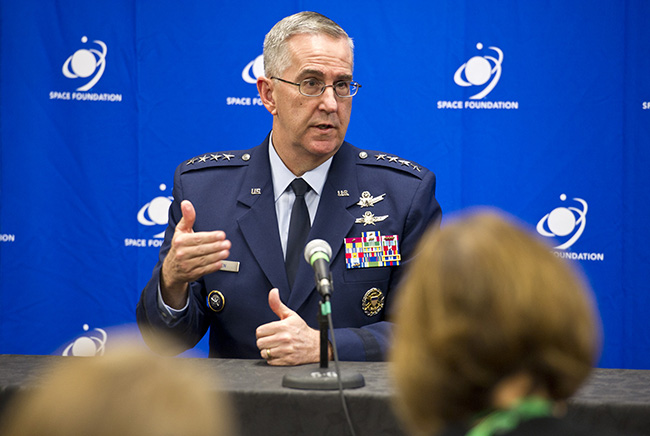
US Strategic Command chief Gen. John Hyten briefs reporters on April 9, 2019, during the 35th Space Symposium in Colorado Springs, Colo. Space Foundation photo.
COLORADO SPRINGS, Colo.—Future nuclear command, control, and communications data should pass through a network of military and commercial systems so complex that adversaries can’t figure out how to stop it, the head of US Strategic Command said this week.
This new NC3 enterprise of 2050 and beyond will rely on a combination of ground, air, and space assets that offer nearly infinite pathways to send data. NC3 systems—largely owned by the Air Force—connect nuclear weapons, aircraft, and submarine operators to high-level government decision-makers in the Pentagon and the White House and ensure America’s nuclear arsenal operates properly.
But times and threats are changing.
“The NC3 of the past was basically building a hardened line through a satellite or through the ground,” Gen. John Hyten said at a media briefing at the Space Foundation’s Space Symposium here Tuesday. “We knew exactly where that line was, we would harden and defend the heck out of that line and make sure that we could always protect that line. Sometimes it went through a Milstar satellite, an [Advanced Extremely High Frequency] satellite, sometimes it went point-to-point on the ground.”
Hyten, who this week was nominated to be vice chairman of the Joint Chiefs of Staff, recently told Congress he’s in the process of turning industry’s recommendations into future system requirements the Pentagon can pursue. Moving forward, NC3 will rely on hardened military space assets, commercial systems, a variety of ground fibers, and air-to-air data links, he said.
The STRATCOM chief, who now oversees NC3 systems engineering, wants to piggyback on the defense world’s embrace of commercial industry.
“How do you have a nuclear capability going through a commercial system? Well, it’s encrypted on one end and encrypted on the other … All you have to do is make sure that [data] packet gets through,” Hyten said.
Including the burgeoning commercial side in a future architecture can open up more ways for data to get through. And though he expects commercial capabilities will offer many of those paths, Hyten said that sector can’t be the only solution because it could go dark in a nuclear emergency.
Perhaps the largest challenge lies in certifying those systems as fail-proof.
“How do we certify this new vision of the future?” Hyten said. “That’s going to be hard to do, because we have to certify it so the President will always trust it. How do you certify something that you’re looking 30, 40, 50 years into the future? … We don’t know how to do that yet.”
It’s not the first time the military has raised that question. In 2017, the Air Force Scientific Advisory Board studied future nuclear surety, focusing on the challenges of certifying multiple new programs at the same time.
“There certainly were resourcing constraints that might limit [the Air Force’s] ability to certify that number of upcoming systems,” James Chow, the board’s former vice chair, told reporters in 2017, according to Inside Defense. “Because of the cyber type of threat, the Air Force should place an increased emphasis on reliability as part of surety. … You cannot ever assure to 100 percent.”
AFSAB recommended the Air Force judge digital-age systems based on how much risk they can take on before they are unreliable or unusable. A pass-fail judgment wouldn’t allow that flexibility.
“The study did not come up with a recommendation of, ‘You should disconnect your systems more,'” Chow said. “It says, ‘Let’s factor that into the equation and this calculus and be able to identify the appropriate risk managers for that,’ and then this goes, ‘Systematically use that calculus to provide the certifiers the right pieces of information to make their decisions.”
Hyten said there’s enough time to work through those details, unlike other nuclear modernization programs, which are expected to come online in about a decade.
“This is one area we’re addressing it where we have time to work through those issues,” he said. “A lot of elements of the nuclear enterprise, we don’t have time—everything is just in time.”